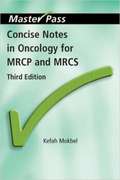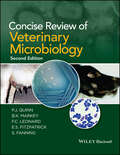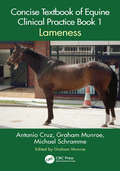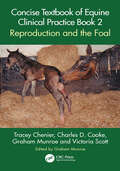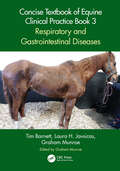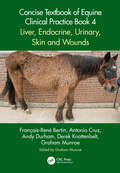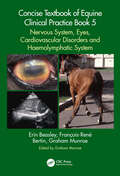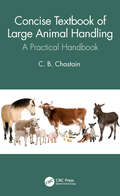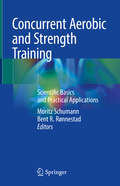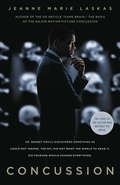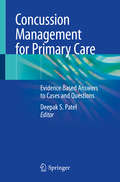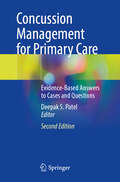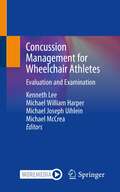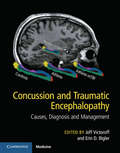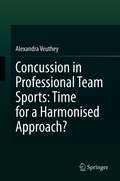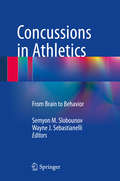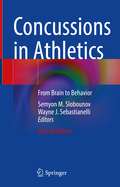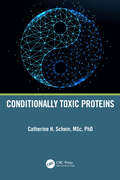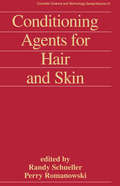- Table View
- List View
Concise Notes in Oncology for MRCP and MRCS (MasterPass)
by Kefah MokbelThis new updated and expanded edition challenges many widely held views on the links between poverty and child health. It brings together new evidence, both historical and current, and considers the practical implications for health and social policy, outlining innovative approaches to future development. Poverty and Child Health is vital reading for paediatricians and child health workers, doctors and health service managers, social service professionals, social scientists and everyone with an interest in shaping health and social policy.
Concise Paediatrics, Second Edition
by Rachel U Sidwell Mike A ThomsonConcise Paediatrics, Second Edition is essential reading for all postgraduates training in paediatrics, particularly when preparing for the MRCPCH exam, and for general practice trainees preparing for the DCH exam. As a comprehensive but concise reference to any condition they are likely to encounter on the wards or in the accident and em
Concise Review of Veterinary Microbiology
by P. J. Quinn S. Fanning F. C. Leonard B. K. Markey E. S. FitzpatrickUpdated to reflect the latest developments in the field, Concise Review of Veterinary Microbiology, 2nd Edition, presents essential information on veterinary microbiology for students and those requiring a refresher on key topics relating to microbial diseases in animals. Morphological, cultural and other descriptive features of pathogenic microorganisms are described, together with their habitats and aetiological roles in disease production in animals and, where appropriate, in the human population. Key features:* There are five sections covering bacteriology, mycology, virology, biosecurity and other aspects of infectious diseases* Provides concise, yet comprehensive information on pathogenic microorganisms of importance in veterinary medicine, the diseases which they cause, their diagnosis and control* The 79 short chapters in this book include 13 new chapters on antibacterial resistance, structure and function of the immune system, antifungal chemotherapy, antiviral chemotherapy, principles of biosecurity and a number of topics related to the control and prevention of infectious diseases* This latest edition uses updated nomenclature and includes detailed diagrams now in full colour, and comprehensive tables
Concise Textbook of Equine Clinical Practice Book 1: Lameness
by Antonio Cruz Graham Munroe Michael SchrammeThis concise, practical text covers the essential information veterinary students, new graduates and practitioners need to succeed in equine practice, focussing on lameness. Written for an international readership, the book conveys the core information in an easily digestible, precise form with extensive use of bullet-points, lists, diagrams, protocols and extensive illustration (over 650 full colour, high quality photographs). Part of a five-book series that extracts and updates key information from Munroe’s Equine Surgery, Reproduction and Medicine, Second Edition, the book distils best practice in a logical straightforward clinical-based approach. It details clinical anatomy, physical clinical examination techniques, diagnostic techniques and normal parameters, emphasising the things regularly available to general practitioners with minimal information of advanced techniques. The clinical information is split into anatomy-based sections. Ideal for veterinary students on clinical placements with horses as well as for practitioners needing a quick reference ‘on the ground’, the spiralbound format allows the book to lie open during practice.
Concise Textbook of Equine Clinical Practice Book 2: Reproduction and the Foal
by Victoria Scott Graham Munroe Tracey Chenier Charles D. CookeThis concise, practical text covers the essential information veterinary students and nurses, new graduates and practitioners need to succeed in equine practice, focussing on reproduction and the foal. Written for an international readership, the book conveys the core information in an easily digestible, precise form with extensive use of bullet-points, lists, diagrams, protocols and extensive illustrations (nearly 200 full colour, high quality photographs). Part of a five-book series that extracts and updates key information from Munroe’s Equine Surgery, Reproduction and Medicine, Second Edition, the book distils best practice in a logical straightforward clinical-based approach. It details clinical anatomy, physical clinical examination techniques, diagnostic techniques and normal parameters, emphasising the things regularly available to general practitioners with minimal information of advanced techniques. The clinical information is split into anatomy-based sections. Ideal for veterinary students and nurses on clinical placements with horses as well as for practitioners needing a quick reference ‘on the ground’.
Concise Textbook of Equine Clinical Practice Book 3: Respiratory and Gastrointestinal Diseases
by Graham Munroe Tim Barnett Laura H. JavsicasThis concise, practical text covers the essential information veterinary students and nurses, new graduates, and practitioners need to succeed in equine medicine, focussing on respiratory and gastrointestinal diseases. Written for an international readership, the book conveys the core information in an easily digestible, precise form with extensive use of bullet points, lists, diagrams, protocols, and extensive illustrations (over 300 full-colour, high-quality photographs). Part of a five-book series that extracts and updates key information from Munroe’s Equine Surgery, Reproduction and Medicine, Second Edition, the book distils best practice in a logical straightforward clinically based approach. It details relevant clinical anatomy, physical clinical examination techniques and findings, normal parameters, aetiology/pathophysiology, differential diagnoses, diagnostic techniques, management and treatment, and prognosis. The emphasis is on information tailored to general equine clinicians with just enough on advanced techniques to make the practitioner aware of what is available elsewhere. The respiratory system is split into sections on surgical and medical conditions of the upper and lower respiratory tracts. The gastrointestinal system is divided into the upper tract, including the oral cavity and dentistry, and the lower tract and peritoneal cavity. Ideal for veterinary students and nurses on clinical placements with horses as well as practitioners needing a quick reference ‘on the ground’.
Concise Textbook of Equine Clinical Practice Book 4: Liver, Endocrine, Urinary, Skin and Wounds
by Antonio Cruz François-René Bertin Andy Durham Derek KnottenbeltThis concise, practical text covers the essential information veterinary students need to succeed in equine medicine and surgery, focussing on skin, urinary, liver and endocrine diseases. Written for an international readership, the book conveys the core information in an easily digestible, precise form with extensive use of bullet points, tables, flow charts, diagrams, lists, protocols and extensive illustrations. Part of a five-book series that extracts and updates key information from Munroe’s Equine Surgery, Reproduction and Medicine, Second Edition, the book distils best practice in a logical straightforward clinical-based approach. It details clinical anatomy, physical clinical examination techniques, diagnostic techniques and normal parameters, emphasising the things regularly available to general practitioners with minimal information of advanced techniques. The liver section is divided into clinical evaluation, diagnostic tests, possible causes and treatment. The diagnostic approach to endocrine disease is followed by specific diseases of the thyroid, parathyroid, pituitary gland, equine metabolic syndrome and other miscellaneous disorders. The approach to urinary tract problems includes information on diagnostic tests and imaging, renal diseases,,and diseases of the ureter, bladder and urethra. The approach to skin disease is discussed in detail, including relevant diagnostic tests. Following this, individual skin diseases are covered under the headings of genetic, infectious, immune-mediated, nutritional, endocrine, idiopathic, traumatic and neoplastic causes. Finally, skin wounds, burns and infections of synovial structures are discussed. Ideal for veterinary students and nurses on clinical placements with horses as well as practitioners needing a quick reference ‘on the ground’.
Concise Textbook of Equine Clinical Practice Book 5: Nervous System, Eyes, Cardiovascular Disorders and Haemolymphatic System
by Graham Munroe François-René Bertin Erin BeasleyThis concise, practical text covers the essential information veterinary students need to succeed in equine medicine and surgery, focusing on the nervous system, eyes, cardiovascular disorders and haemolymphatic systems. Written for an international readership, the book conveys the core information in an easily digestible, precise form with extensive use of bullet points, tables, flow charts, diagrams, lists, protocols and extensive illustrations. Part of a five-book series that extracts and updates key information from Munroe’s Equine Surgery, Reproduction and Medicine, Second Edition, the book distils best practice in a logical straightforward clinical-based approach. It details clinical anatomy, physical clinical examination techniques, diagnostic techniques and normal parameters, emphasising the things regularly available to general practitioners with minimal information of advanced techniques. The nervous system section discusses in detail the neurological exam, mentions relevant diagnostic tests and divides the diseases of the system into congenital, infectious, traumatic, toxin-induced and miscellaneous causes. In the eye section, the relevant anatomy and the examination of the eye are followed by discussion of useful diagnostic tests and procedures. Diseases of the eye are discussed under the headings of congenital/neonatal, neoplastic, infectious and inflammatory disorders, neurological based and parasitic problems. The cardiological examination and relevant diagnostic tests are followed by sections on arrhythmias, congenital and acquired cardiac diseases, pericardial disease and miscellaneous cardiovascular disease. Finally, the haemolymphatic section discusses in detail relevant diagnostic approaches and laboratory aids, followed by sections on anaemia, haemostasis disorders, infections and neoplasia. Ideal for veterinary students and nurses on clinical placements with horses, as well as practitioners needing a quick reference ‘on the ground’.
Concise Textbook of Large Animal Handling: A Practical Handbook
by C. B. ChastainThis concise instructional guide condenses the most important aspects of large animal handling. It provides a portable, durable, beside-the-animal means of learning, as well as a convenient way to refresh on how to strive for safety and efficacy in animal handling techniques. It is ideal for use during veterinary placements in all settings from farm to laboratory, to riding school. The text covers: • Handler safety • Animal safety • Sanitation • Approach and capture • Routine handling and release procedures • Handling for medical procedures • Use and supply sources of restraint equipment A Companion Website provides additional self-assessment questions and answers to aid learning. Important reading for undergraduate veterinary students on EMS rotations, as well as practicing veterinarians, technicians, and assistants, the book covers species encountered in farm, equine, and laboratory settings.
Concise Textbook of Small Animal Handling: A Practical Handbook
by C. B. ChastainThis instructional pocket reference condenses the most important aspects of small animal handling. It provides a portable, durable means of learning 'on the ground', as well as a convenient way to refresh on how to strive for safety and efficacy in animal handling techniques. Spiralbound for practical use at the animal’s side during veterinary placements in a clinic or laboratory, the text covers: Handler safety Animal safety Sanitation Approach and capture Routine handling and release procedures Handling for medical procedures Use and supply sources of restraint equipment A Companion Website provides additional self-assessment questions and answers to aid learning. Important reading for undergraduate veterinary students as well as practicing technicians, nurses and assistants, the book instructs on safe and humane handling of species encountered in both small animal practice and laboratory settings.
Concordance in Medical Consultations: A Critical Review
by Kristian PollockThe capacity of professional medicine to resist change - and also concordance - is impressive, but perplexing. It is one of the issues I seek to address in this book. I suggest that a preoccupation with trying to change the relationship between the professional-patient dyad has deflected attention from the extent to which such relations are embedded in, and constrained by, wider administrative and organisational structures, especially as these relate to the operation of professional hierarchies and interprofessional deference and allegiances. Barriers to change also result from the inertia of a system which has evolved a highly stylised etiquette as an adaptive mechanism to contain the difficulties and tensions intrinsic to the medical consultation. Its therapeutic purpose and potential are often subordinate to the goal of achieving success as a social encounter. The principles of concordance are deeply challenging to traditional professional roles and status. However, medicine has always displayed an ability to block change through tactics of appropriation and incorporation. Professionals have often shown particular difficulty giving up their monopoly of 'expertise' and in acknowledging the legitimacy of the patient perspective. Although the term 'concordance' has become quite widely used, its meaning is usually subverted by its employment as a synonym for 'compliance', albeit 'informed' compliance. A slightly more sophisticated version values professional elicitation of the patient perspective in order to more accurately tailor information as a means of overcoming the unhelpful m/sconceptions that impede compliance. The original emphasis on the consultation as a negotiated exchange, in which the professional has something of value to learn from the patient, has largely been lost. The rhetoric of modernity and change provides an effective mask for inertia and conservatism. Preface.
Concurrent Aerobic and Strength Training: Scientific Basics and Practical Applications
by Moritz Schumann Bent R. RønnestadThis book provides an extensive guide for exercise and health professionals, students, scientists, sport coaches, athletes of various sports and those with a general interest in concurrent aerobic and strength training. Following a brief historical overview of the past decades of research on concurrent training, in section 1 the epigenetic as well as physiological and neuromuscular differences of aerobic and strength training are discussed. Thereafter, section 2 aims at providing an up-to-date analysis of existing explanations for the interference phenomenon, while in section 3 the training-methodological difficulties of combined aerobic and strength training are elucidated. In section 4 and 5, the theoretical considerations reviewed in previous sections will then be practically applied to specific populations, ranging from children and elderly to athletes of various sports. Concurrent Aerobic and Strength Training: Scientific Basics and Practical Applications is a novel book on one of the “hot topics” of exercise training. The Editors' highest priority is to make this book an easily understandable and at the same time scientifically supported guide for the daily practice.
Concussed: Sport's Ticking Timebomb
by Sam PetersBy recounting the untold story of the most influential sports campaign in British newspaper history, which turned concussion in professional rugby from a niche issue into front and back page news, Concussed poses the questions all sports lovers need answering as evidence grows linking sports-related concussions to premature deaths and dementia.Written by Sam Peters, the journalist who spearheaded the Mail on Sunday's Cudlipp Prize nominated concussion campaign, Concussed reveals one man's attempts to blow the whistle on a mounting head injury crisis. For years, his efforts saw him labelled a 'pariah' and almost forced him out of the sport he loved for good.Including exclusive interviews with bereaved families whose stories have never been told before, as well as high-profile administrators, medics, current and past players, coaches, lawyers and media figures, Peters recounts the countless battles he fought and the threats he faced in a sport whose macho culture masked the urgent need to radically overhaul player welfare standards. Expanding his research from rugby to football, NFL and cricket, Peters brings an unparalleled breadth of experience and depth of knowledge to a subject he has written about and campaigned over for almost a decade. Now sport's 'dirty secret' is out in the open, Peters asks what it must now do to ensure future generations of players are not left permanently damaged and how parents can be persuaded their children are safe to play contact sports. Ultimately, in an increasingly risk-averse world, Concussed: Sport's Ticking Timebomb asks: will concussion kill sport?
Concussion
by Jeanne Marie Laskas<P>Soon to be a major motion picture starring Will Smith, Concussion is the riveting, unlikely story of Dr. Bennet Omalu, the pathologist who made one of the most significant medical discoveries of the twenty-first century, a discovery that challenges the existence of America's favorite sport and puts Omalu in the crosshairs of football's most powerful corporation: the NFL. <P>Jeanne Marie Laskas first met the young forensic pathologist Dr. Bennet Omalu in 2009, while reporting a story for GQ that would go on to inspire the movie Concussion. Omalu told her about a day in September 2002, when, in a dingy morgue in downtown Pittsburgh, he picked up a scalpel and made a discovery that would rattle America in ways he'd never intended. <P>Omalu was new to America, chasing the dream, a deeply spiritual man escaping the wounds of civil war in Nigeria. The body on the slab in front of him belonged to a fifty-year-old named Mike Webster, aka "Iron Mike," a Hall of Fame center for the Pittsburgh Steelers, one of the greatest ever to play the game. After retiring in 1990, Webster had suffered a dizzyingly steep decline. Toward the end of his life, he was living out of his van, tasering himself to relieve his chronic pain, and fixing his rotting teeth with Super Glue. <P>How did this happen?, Omalu asked himself. How did a young man like Mike Webster end up like this? The search for answers would change Omalu's life forever and put him in the crosshairs of one of the most powerful corporations in America: the National Football League. <P>What Omalu discovered in Webster's brain--proof that Iron Mike's mental deterioration was no accident but a disease caused by blows to the head that could affect everyone playing the game--was the one truth the NFL wanted to ignore. <P> Taut, gripping, and gorgeously told, Concussion is the stirring story of one unlikely man's decision to stand up to a multibillion-dollar colossus, and to tell the world the truth. <P><b>A New York Times Bestseller</b>
Concussion Management for Primary Care: Evidence Based Answers to Cases and Questions
by Deepak S. PatelConcussions are increasing in incidence each year, and each state has a law on management of concussions in children. These factors strengthen the need for primary care providers to be well-versed in the evaluation and management of them. This text provides primary care physicians and clinicians with an evidence-based yet practical approach to diagnosing and treating concussions in children and adults.The book begins with a general overview of concussions. It then goes on to identify risks, signs and symptoms of concussions. Next, physicians and providers learn when and how to perform appropriate physical exams for suspected concussions. The following chapters focus on finding the correct type of testing to perform in suspected concussions. The testing options addressed include diagnostic, neurocognitive and imaging. Return-to-learn and return-to-play recommendations are then discussed to ensure that providers are able to properly educate patients on them. The book concludes by explaining post-concussion syndrome and identifying methods to prevent concussions and complications in the future. Each chapter presents a specific case along with 3-5 followup questions as well as a summary of key concepts. Written from the unique perspective of a primary care physician who also specializes in sports medicine and concussions, Concussion Management for Primary Care is a first-of-its-kind book that serves as a valuable resource for primary care physicians, sports medicine physicians and any other clinician treating patients suffering from a possible concussion.
Concussion Management for Primary Care: Evidence-Based Answers to Cases and Questions
by Deepak S. PatelConcussions remain a common problem for all ages and not just specific for athletes. Recent scientific literature has expanded our understanding of concussions. Therefore, concussion guidelines and recommendations continue to evolve. All health care professionals and clinicians are often challenged to keep up with these advances. Written from the unique perspectives of a primary care physicians who also specialize in sports medicine and have extensive concussion clinical experience, Concussion Management for Primary Care, 2e serves as a valuable resource for physicians, providers, and any other clinician evaluating or treating patients with a possible concussion. This fully revised and expanded second edition, provides evidence-based yet practical approach to diagnosing and treating concussions in children and adults. Each chapter includes practical, clinically based questions and explanations. An updated literature search and clinical expertise is included in each section. The chapters conclude with a &“key points&” section with quick and essential take home points. All these features make this text an invaluable resource to anyone wanting to learn more about concussions.
Concussion Management for Wheelchair Athletes: Evaluation and Examination
by Kenneth Lee Michael William Harper Michael Joseph Uihlein Michael McCreaThis book arises from the challenges and difficulties involved in the evaluation and management of concussions in wheelchair athletes. Concussions are most readily identified in the ambulatory population via identifying gross motor instability or when athletes lose their balance and stumble after a blow to the head or neck region. Because wheelchair athletes participate in sport while sitting down and using a wheelchair, clinicians must be extra attentive to identify a potential concussion. Once a potential concussion is identified, there are many challenges in evaluation of the wheelchair athlete population due to their comorbidities. At baseline, they may have signs and symptoms that mimic a concussion, and their impairments can also alter their cognitive and balance assessments. Therefore, it is critical to make a distinction between these athletes’ baseline comorbid impairments and potential new exam findings in a concussion. Filling in a critical gap in the literature, this is a concise pocket guide for any clinician, trainer, or rehabilitation specialist who is involved in wheelchair sports. It focuses on the unique challenges in evaluating a concussion in the wheelchair athlete, including baseline testing, the process of evaluating the signs and symptoms of a concussion, cognitive and vestibular examination, new clinical techniques specific to wheelchair athletes, and the return to play process. A Concussion Management Program (CMP) for use on the sideline as well as in the office is included. Practical and timely, Concussion Management for Wheelchair Athletes is a valuable resource to increase awareness, provide guidance on the unique challenges within this population, and generate interest in future research and investigation.
Concussion and Traumatic Encephalopathy: Causes, Diagnosis and Management
by Erin D. Bigler Jeff VictoroffConcussion and Traumatic Encephalopathy is a ground breaking text that offers neurologists, neuropsychologists, psychologists, and physiatrists the first comprehensive reconceptualization of concussive brain injury in 100 years. During the twentieth century, progress in understanding concussion was hamstrung by resistance to the observation that many survivors suffer long-term sequelae, and by the lack of advanced neuroimaging technologies. As a result, the potentially immense impact of concussion on global health was largely overlooked. The last decade has witnessed a dramatic renaissance in concussion science. We are just beginning to fathom the implications for society. Informed by twenty-first century advances, this new text updates the definition, epidemiology, pathophysiology, late effects, and promising therapies for concussion. Multiple experts have collaborated to summarize the latest scientific evidence in an engaging way and provide the reader with the first paradigm shifting textbook of this new era.
Concussion in Professional Team Sports: Time for a Harmonised Approach?
by Alexandra VeutheyThe risk of athletes sustaining concussion while participating in professional team sports raises two serious concerns both nationally and internationally.First, concussion in sport carries a public health risk, given that injured athletes may have to deal with significant long-term medical complications, with some of the worst cases resulting in Chronic Traumatic Encephalopathy (CTE).Secondly, sports governing bodies are now exposed to the risk of financial and reputational damage as a consequence of legal proceedings being filed against them. A good example of this, among many other recent examples, is the case of the United States of America’s National Football League (NFL), the governing body for American football, which, in 2015, committed to pay US$ 1 billion to settle the class action filed by its former professional players.This book examines how to most efficiently reduce these public health and legal risks, and proposes a harmonised solution across sports and legal systems.
Concussions in Athletics: From Brain to Behavior
by Semyon M. Slobounov Wayne J. SebastianelliConcussions in Athletics: From Brain to Behavior is a timely and major contribution to the literature that comprehensively addresses the neuromechanisms, predispositions, and latest developments in the evaluation and management of concussive injuries. Also known as mild traumatic brain injury, concussion in athletics is a growing public health concern with increased attention focusing on treatment and management of this puzzling epidemic. Despite the increasing occurrence and prevalence of concussions in athletics, there is no universally accepted definition, or "gold standard," for its assessment. Concussion in Athletics: From Brain to Behavior provides a range of major findings that may shed important light on current controversy within the field. The book is organized in five parts: Evaluation of Concussion and Current Development; Biomechanical Mechanisms of Concussion and Helmets; Neural Substrates, Biomarkers and Brain Imaging of Concussion Research; Pediatric Sport-related Concussions; and Clinical Management and Rehabilitation of Concussions. An invaluable contribution to the literature, Concussions in Athletics: From Brain to Behavior is a state-of-the-art reference that will be of significant interest to a wide range of clinicians, researchers, administrators, and policy makers.
Concussions in Athletics: From Brain to Behavior
by Semyon M. Slobounov Wayne J. SebastianelliNow in a fully revised and expanded second edition, this comprehensive text remains a timely and major contribution to the literature that addresses the neuromechanisms, predispositions, and latest developments in the evaluation and management of concussive injuries. Concussion, also known as mild traumatic brain injury, continues to be a significant public health concern with increased attention focusing on treatment and management of this puzzling epidemic as well as controversies within the field. The book is comprised of five thematic sections: current developments in evaluation; biomechanical mechanisms; neural substrates, biomarkers, genetics and brain imaging; pediatric considerations; and clinical management and rehabilitation. Since the publication of the original edition in 2014, much has changed regarding the current understanding of mild traumatic brain injury including development of more precise imaging modalities, development and classification of new biomarkers, and updates to clinical treatment and management of athletic concussion. This new edition will include new chapters targeting the influence of genetics on concussive injury, as well as an expansion on the knowledge of pediatric response to concussion and the influence of repetitive subconcussive impacts on athlete health. An invaluable contribution to the literature, Concussions in Athletics: From Brain to Behavior reestablishes itself as a state-of-the-art reference that will be of significant interest to a wide range of clinicians, researchers, administrators, and policy makers, and this updated version aims to narrow the gap between research findings and clinical management of sports-related concussion and other mild traumatic brain injury. The second edition also attempts to broaden the scope of the knowledge to apply to more professionals and pre-professionals in the fields of neuroscience, neuropsychology, and other allied health professionals that closely work with athletes and sports medicine professionals.
Concussions: Hitting the Brain Hard (Fountas & Pinnell Classroom, Guided Reading Grade 5)
by Carla MooneyHead Shot A soccer player jumps up to head the ball into the goal, but her teammate has the same idea. As both players jump, their heads collide and one player falls to the ground. She gets up but feels foggy and confused. She's hurt, but her injury isn't obvious—there are no cuts or broken bones. Yet her injury is very serious: concussions are invisible dangers. NIMAC-sourced textbook
Concussive Brain Trauma: Neurobehavioral Impairment & Maladaptation, Second Edition
by Rolland S. ParkerFocusing on a public health problem affecting millions of people of all ages, the second edition of Concussive Brain Trauma: Neurobehavioral Impairment and Maladaptation reflects Dr. Rolland S. Parker's more than 25 years of neuropsychological practice and research in traumatic brain injury and stress, and his prior experience as a clinical psychol
Conditionally Toxic Proteins
by Catherine H. ScheinHuman health depends upon access to high-quality proteins for our diet and pharmaceutical use. This book deals with the nature of toxicity as it applies to proteins in food and drugs. Many proteins, such as glutens and allergens, are valuable food sources but toxic for sensitized individuals. Even proteins produced in the human body can become toxic through mutation or aggregation. For example, Alzheimer's and Huntington's disease are characterized by plaques in the brain of insoluble protein aggregations. Paradoxically, even toxins produced by the most pathogenic microorganisms, such as Botox, have found use in the clinic and industry. This book discusses how many proteins, including interferons and cytokines, can be valuable therapeutics, while still associated with autoimmune diseases, such as psoriasis or lupus erythematosus. Key Features: Shows why gluten proteins are different from all others and how this can account for symptoms throughout the body in those with celiac disease Illustrates that "multiple allergy syndrome" is not only real and related to similar allergens in extremely different plants Discusses the difficulties in using human proteins and cytokines as therapeutics Presents examples of how protein aggregates are vital to many physiological processes but also characterize renal and neurological syndromes Shows examples of protein toxins that have medical and industrial uses Related Titles Almeida, P. Proteins: Concepts in Biochemistry (ISBN 978-0-8153-4502-2) Williamson, M. How Proteins Work (ISBN 978-0-8153-4446-9) Lopata, A. L., ed. Food Allergy: Molecular and Clinical Practice (ISBN 978-0-3677-8199-6) Wegrzyn, R. D. & A. S. Rudolph, eds. Alzheimer’s Disease: Targets of New Clinical Diagnostic and Therapeutic Strategies (ISBN 978-1-4398-2708-6)
Conditioning Agents for Hair and Skin (Cosmetic Science And Technology Ser. #21)
by Randy SchuellerDiscussing the history, benefits, formulations and future developments of hair and skin conditioning products, this work offers an overview of the subject and unique analysis of the elements of conditioning. It offers the novice chemist a solid foundation of technical knowledge and the seasoned scientist the latest state-of-the-art ingredients and testing procedures used in evaluation.
